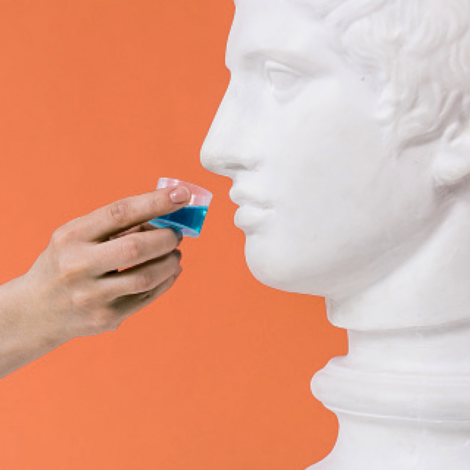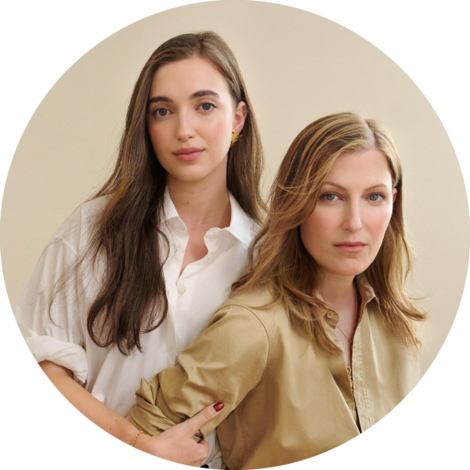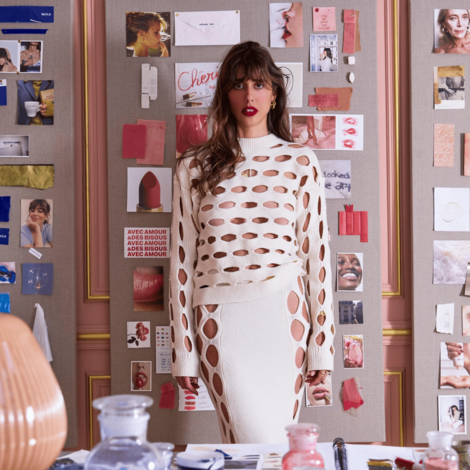“The Female Founder” is a gruesome short story that begins, uncannily, in the manner of an Architectural Digest tour. In it, a film crew moves cautiously, and with increasing bewilderment, through what seems to be an evil fun house of corporate feminism, its mirrors shaped like Michelle Obama.
The titular founder, clearly image-obsessed, speaks either in perfect press release or offers lovely but empty overtures to the group of strangers: “My home is your home, you should all come to my next women in tech dim sum!” The plot turns on the discovery of a basement, which is actually a sweatshop staffed by “20-something” women with “cracked, bleeding” hands. The founder announces, “Meet my all-female team!”
For anybody who has observed the particular performance of a particular corporate figure from a particular era, it is a perfect pink Ladurée macaron of a short story. Its author, Emily Sundberg, 30, has studied the subject. Sundberg toiled in the girlboss economy of the 2010s for a women’s magazine, a cookware start-up, and Instagram, and she had an appetite for expressing and discussing the young, rich, and increasingly renowned founders she worked for. When Bloomberg’s Matt Levine linked out to Sundberg’s story, which was published in her Substack newsletter, Feed Me, she realized that others might have that appetite, too.
Less than five years later, Feed Me has become a compulsively readable daily business newsletter that Sundberg likens to a budding media organization, of which she is ostensibly editorial director, senior writer, fact-checker, publicist, and influencer. She now employs three additional columnists, including a restaurant critic; maintains a growing advertising business; hosts events and happy hours for her readers; and has, somewhat suddenly, become the most talked-about young woman in new media—a remarkable feat, given Olivia Nuzzi’s fourth quarter—as well as an object of Internet snark.
Sundberg used to open each Feed Me dispatch with a Webcam selfie but did away with the practice during her most recent rebrand. (“I don’t want my face to be the reason why this is successful,” she said recently on the Tasteland podcast.) “On Reddit, a bunch of people are like, ‘She has bad lip filler,’” Sundberg told me on a recent cold Monday morning in a too-crowded coffee shop near her Brooklyn apartment. Wearing a fuzzy red scarf, fuzzier red zip-up, and brown coat, she turned to a mirror to inspect her lips. “It’s weird,” she continued. “People don’t think you should be a great writer with real lips.” She does admit, Kylie Jenner–ly, that she’s a fan of over-lining them.
Sundberg wakes up at six a.m. and begins every day with coffee. On a good morning, she will already have a few tips in her inbox. On a slow morning, she takes the subway into Manhattan and goes hunting for them, eavesdropping at stores or gazing at billboards. On this morning, she had a good one locked and loaded: the previous night, somebody sent her a letter written by the owner of a West Village building best known as the exterior of Carrie Bradshaw’s apartment on Sex and the City, and it was kind of bitchy.
“I don’t want my face to be the reason why this is successful.”
Barbara Lorber owned the building prior to the show’s filming. (“My fault: I felt sorry for the young location scout who was a recent grad from N.Y.U. film school.”) She confessed her bewilderment at its enduring fame and advocated for the installation of a gate to deter tourists. This was local news at best, but it was juicy enough to headline Feed Me’s Monday e-mail (“The Post hasn’t even picked this up yet”), from which point it went global. The New York Times, The Washington Post, and The Hollywood Reporter picked it up, as did The Guardian and Sky News Australia.
For any reporter, this would be a year-making achievement; for Sundberg, it’s just another Monday. Critics of Sundberg might distinguish her from other journalists by her reporting credentials, which were honed not covering news but on the social-media desks in newsrooms. For her part, she confirms every story with at least two sources before running with it and has been known to D.M. a founder directly for the tea. A lot of information comes to her palm from her interconnected nebulae of group chats.
“My friends who were billionaires would actually text about this—‘Oh, do you know that this investor bought a house in East Hampton right across from this person?,’” Sundberg said. “The Wall Street Journal would [have] never put that line in two and a half years ago.” She blinks. “Today, they might.”
They might because they know Sundberg will. The newsletter format lends itself to a kind of hybrid of gossip and news, sometimes leaning on unattributed sources or dubious social-media rumblings to frame a story. Last year, Feed Me picked up a TikTok where an angry guest at Gurney’s hotel and resort in Montauk encountered a CeraVe advertisement on a mirror in their room—Sundberg called it “gross” marketing—even though a simple phone call to the hotel would have confirmed that the ad was accidentally left over from an influencer trip the week before. But the undeniable pro to this approach is that, often, newsletters such as Feed Me—or the more buttoned-up Puck—break news well before legacy institutions, which are weighed down by their editorial standards.
“I get very competitive,” Sundberg said.
There was a recent rumor about New York’s forthcoming Prada restaurant. “I got a tip from a friend of mine who works in real estate, and I asked him 10 times, ‘Are you sure? Are you sure?’” He was sure, and Sundberg wrote it up. The next morning, she awoke to her Google Alerts buzzing from outlets like the New York Post and Grub Street covering the news and linking back to Feed Me. “And then Puck wrote something like, ‘This is not confirmed,’ and I remember reading it and being like, ‘But they confirmed it to me,’ right?”
On one hand, it was an anxiety-inducing episode. On the other hand … the referral traffic! “It was a risk for me to publish that, not having somebody with a Prada signature e-mail me saying ‘Confirmed,’ but it ended up being correct.” She added, “A lot of that is just gut instinct.”
Other times, Feed Me will take another outlet’s story and expand upon it, like when The Wall Street Journal wrote about men in their 30s failing to launch and Sundberg invited one of them into her chat. Feed Me’s comments section and chat room are both exclusive to paid subscribers, who form a community of thousands. Sundberg has said that about 10 percent of her audience pays, which, with ads, suggests that the newsletter generates north of a few hundred thousand dollars a year—and is growing. “Do you want to write for me?,” Sundberg offered as our interview was ending. “I pay really well.” I believe her.
Sundberg has always lived online. “I once joked in an interview that I was really skinny in high school because I spent all my time in bed on Tumblr,” she said.
Still, she found herself animated to Do Things even from a young age. Sundberg was born and raised in Centerport, Long Island, a North Shore hamlet near Oyster Bay. She served as the president of her school’s National Art Honor Society and also played lacrosse. Her obsession with the immediate world around her, combined with her fascination with powerful individuals, moved her attention easterly; during the pandemic, she directed a documentary called The End, about Gardiner’s Island, which sits in the maw between the North and South Forks, and one of her favorite papers is The East Hampton Star.
Sundberg attended the Fashion Institute of Technology, in large part because it was inexpensive and in Manhattan, and interned for NBC and Yahoo during a time when these institutions were just beginning to figure out social media—and increasingly handing the reins to twentysomething interns. She landed one of her first jobs at New York magazine on the social team, presiding over the Cut’s Instagram. “In 2016, it was Weinstein, Trump, Justin, and Hailey,” she said. “Just a great time to be moderating a comment section.”
It was also boom times for New York’s consumer-goods start-ups, and when the cookware brand Great Jones launched, Sundberg came on to run their Instagram, which she did with an editorial flourish, interspersing commercial photography with kitchen scenes from The Last Days of Disco or the Nancy Meyers canon. The “#kitchenstudy” series continued for years, but Sundberg left in 2019, going on to consult and then work for Instagram.
The year 2020 was one of many upheavals. For Sundberg, it marked the death of the girlboss—that caricature of a female founder born of the start-up age, a term of pride that soured with extended exposure to misogyny. Some of the bosses struggled, in the glaring public eye, to reckon with movements like Black Lives Matter and the inequality laid bare by the coronavirus pandemic; others became the subject of reported stories that served to expose the fragility of the start-up era but could not help willfully recounting their bitchiest she-E-O moments. One example was a Business Insider story about the feuding female co-founders of Great Jones, one of whom was “image-obsessed” and accused of poor management.
Sundberg didn’t talk about her ex-bosses, but I spoke to a few of her former colleagues, who said that she sometimes clashed with management figures, especially ones who were stodgy in their ideas about media. And her contempt for the girlboss is clear; a few months before the Great Jones exposé, Sundberg published “The Female Founder,” one of her most-read stories to date.
Her audience is united in their demeanor—opinionated, funny, a little snooty—as well as in their niche interest in things like the business dealings of the olive-oil brand Graza. But they come from all economic walks of life. “There’s an investor cohort, and then there’s bartenders, and then there’s people who are real-estate agents, and then there’s random townies from East Hampton, and then there’s people who work in the beauty-and-fashion industry,” Sundberg said. An audience, she points out, is a strong part of a media organization, and Sundberg has cultivated a highly tasteful readership in part by enmeshing herself within New York’s media elite—linking out to other writers and editors, attending parties thrown by Bari Weiss—and in larger part with cold, hard, old-fashioned gossip.
She estimates that two-thirds of her income comes from some 6,000 subscriptions, with the remaining third from Feed Me’s intermittent ad business. You could make the argument that an editor’s covering brands while also collaborating with them is a gray area, but you could not argue that it’s different than what publishers like Condé Nast have done for decades, with diminishing returns. You could also not argue it’s a bad idea, especially if you’re one of those brands hoping to throw themselves onto Sundberg’s radar. Last fall, the beauty label Merit launched its first fragrance through a sponsored Feed Me newsletter.
Like many before her, Sundberg is hoping to turn what was once a blog into an institution. But in envisioning her future, it’s easy to wonder how she will reconcile the creative within her with the media mogul she wants to be. Sundberg’s biggest strength, far stronger than her gut or her perspective, is her voice. “I’ve gotten feedback about the way I write being too opinionated and confident, and I’ve had a few unsubscribe notes with people being like, ‘I don’t like your tone,’ and I think that’s fine.” She wondered genuinely, “What’s the alternative?”
Brennan Kilbane is a New York–based writer and the beauty editor at The Business of Fashion. He is originally from Cleveland, and his interviews and essays have appeared in Allure, GQ, and New York magazine





